Assessing Sponge Cities Performance at City Scale Using Remotely Sensed LULC Changes: Case Study Nanjing
Abstract
1. Introduction
2. Volume Capture Ratio of Annual Rainfall (VCRa)
3. Site Design
4. Data and Methods
4.1. Data and Classification
4.2. State Vector, Transition Matrix, and Visualization
4.3. Precipitation Runoff Volume Control
5. Results and Discussion
5.1. LULC Changed from 1985 to 2015 at the City Level
5.2. VCRα-L
6. Conclusions
Author Contributions
Funding
Data Availability Statement
Acknowledgments
Conflicts of Interest
Appendix A
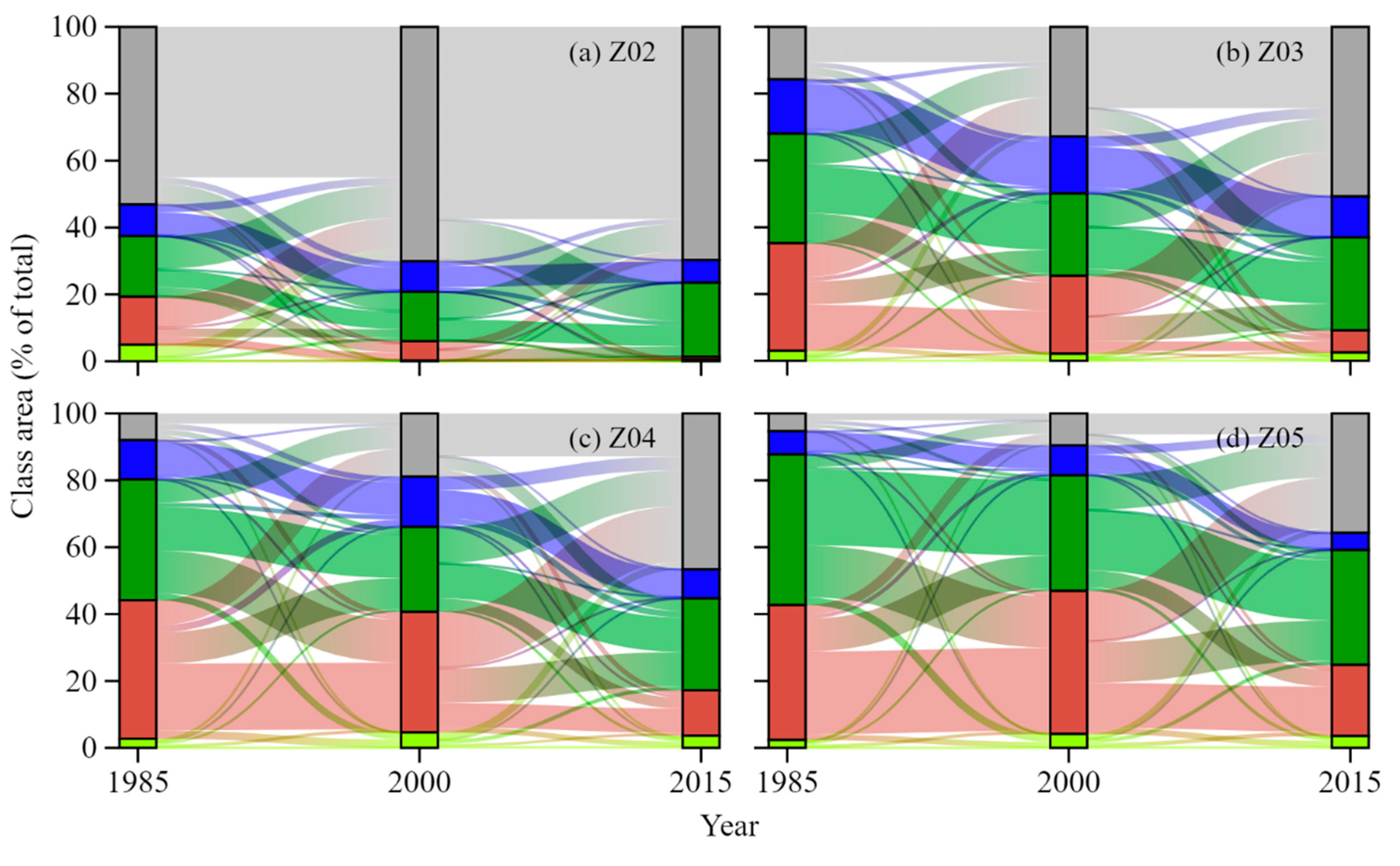
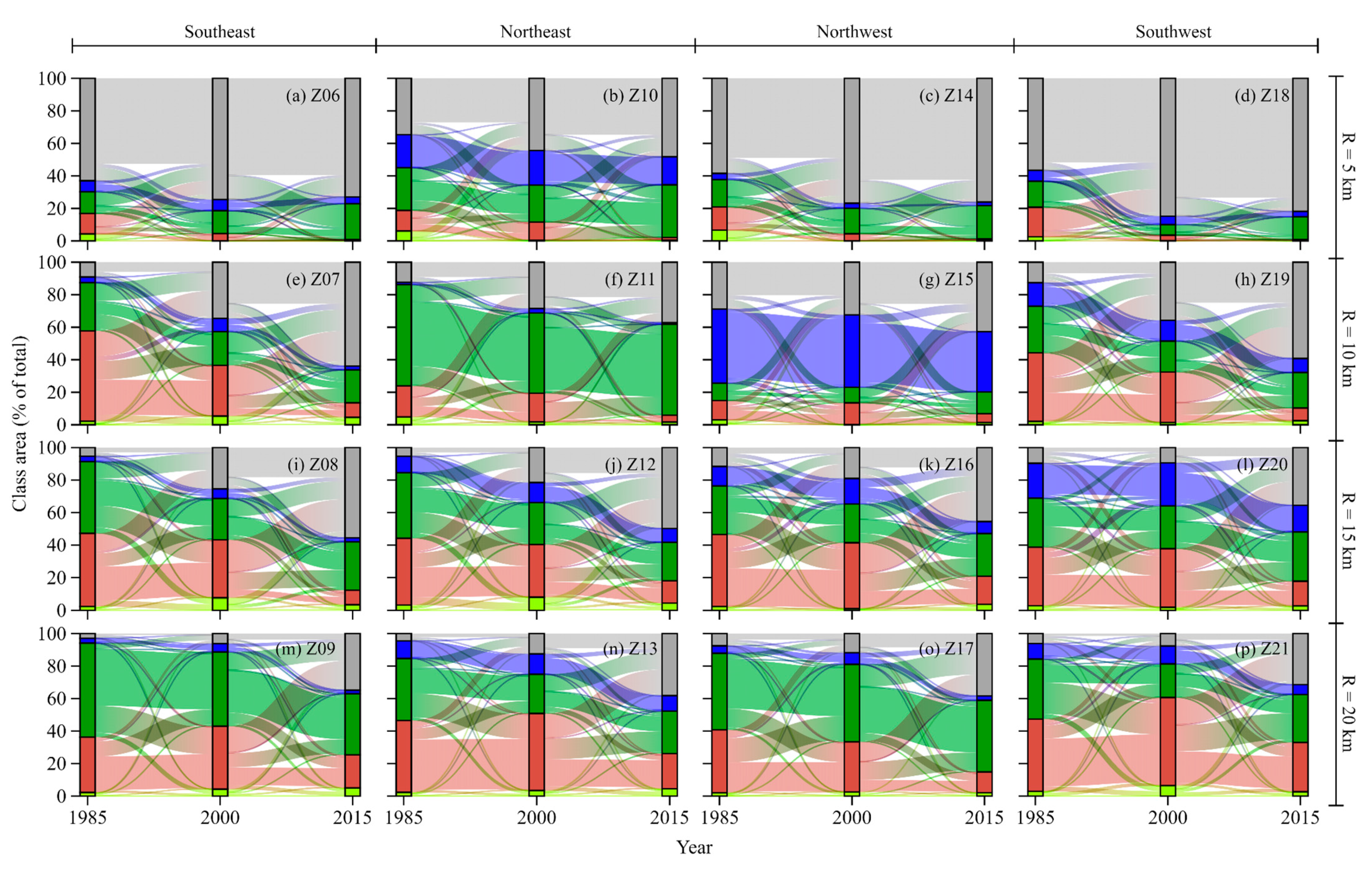
| Year | Urban and Built-Up Lands | Water Bodies | Mixed Forests | Croplands | Grasslands |
|---|---|---|---|---|---|
| 1985 | 11.09 | 10.35 | 38.26 | 37.54 | 2.76 |
| 2000 | 20.6 | 12.41 | 28.58 | 34.74 | 3.67 |
| 2015 | 44.08 | 7.66 | 30.23 | 14.85 | 3.18 |
| Urban and Built-Up Lands | Water Bodies | Mixed Forests | Croplands | Grasslands | |
|---|---|---|---|---|---|
| Urban and built-up lands | 6.64 | 1.44 | 1.81 | 1.14 | 0.06 |
| Water bodies | 0.7 | 8.52 | 0.41 | 0.71 | 0 |
| Mixed forests | 6.17 | 0.91 | 16.91 | 12.51 | 1.77 |
| Croplands | 6.09 | 1.43 | 8.69 | 19.52 | 1.82 |
| Grasslands | 1 | 0.1 | 0.77 | 0.86 | 0.02 |
| Urban and Built-Up Lands | Water Bodies | Mixed Forests | Croplands | Grasslands | |
|---|---|---|---|---|---|
| Urban and built-up lands | 14.91 | 0.09 | 3.83 | 1.22 | 0.55 |
| Water bodies | 3.09 | 7.21 | 1.49 | 0.51 | 0.1 |
| Mixed forests | 10.29 | 0.1 | 13.83 | 3.53 | 0.83 |
| Croplands | 14.21 | 0.25 | 10.1 | 8.71 | 1.47 |
| Grasslands | 1.57 | 0.01 | 0.98 | 0.89 | 0.23 |
References
- Han, F.; Xu, J.; He, Y.; Dang, H.; Yang, X.; Meng, F. Vertical structure of foggy haze over the beijing-tianjin-hebei area in january 2013. Atmos. Environ. 2016, 139, 192–204. [Google Scholar] [CrossRef]
- Li, X.; Gao, Z.; Li, Y.; Gao, C.Y.; Ren, J.; Zhang, X. Meteorological conditions for severe foggy haze episodes over North China in 2016–2017 winter. Atmos. Environ. 2019, 199, 284–298. [Google Scholar] [CrossRef]
- Fan, L.; Sha, H.; Pang, Y. Water environmental capacity of lake Taihu. J. Lake Sci. 2012, 24, 693–697. [Google Scholar] [CrossRef]
- Zhang, C.; Xie, G.; Lu, C. Research on scarcity degree of chinese water environment capacity and its interactions with regional function. Resour. Sci. 2009, 31, 559–565. [Google Scholar]
- Wang, X.; Wang, Y.; Sun, C.; Pan, T. Formation mechanism and assessment method for urban black and odorous water body: A review. Chin. J. Appl. Ecol. 2016, 27, 1331–1340. [Google Scholar] [CrossRef]
- Yang, Z.; Zhang, M.; Shi, X.; Kong, F.; Ma, R.; Yu, Y. Nutrient reduction magnifies the impact of extreme weather on cyanobacterial bloom formation in large shallow Lake Taihu (China). Water Res. 2016, 103, 302–310. [Google Scholar] [CrossRef] [PubMed]
- Schueler, T.R. The importance of imperviousness. Watershed Prot. Tech. 1995, 1, 100–111. [Google Scholar]
- Federal Interagency Stream Restoration Working Group (FISRWG). Stream Corridor Restoration: Principles, Processes, and Practices.; Federal Interagency Stream Restoration Working Group (FISRWG): Washington, DC, USA, 1998; ISBN 0-934213-59-3.
- Yu, M.; Li, Q.; Hayes, M.J.; Svoboda, M.D.; Heim, R.R. Are droughts becoming more frequent or severe in china based on the standardized precipitation evapotranspiration index: 1951–2010? Int. J. Climatol. 2014. [Google Scholar] [CrossRef]
- Edogawa River Office Metropolitan Outer Area Underground Discharge Channel. Available online: https://www.ktr.mlit.go.jp/edogawa/edogawa_index045.html (accessed on 3 October 2019).
- Beijing Municipal Administration of Quality and Technology Supervision. Code for Design of Stormwater Management and Harvest Engineering (DB11/685-2013); Beijing Municipal Administration of Quality and Technology Supervision: Beijing, China, 2013. [Google Scholar]
- National Research Council. Urban Stormwater Management in the United States; National Research Council: Washington, DC, USA, 2008; ISBN 0-309-12540-5. [Google Scholar]
- Clar, M.L.; Barfield, B.J.; O’Connor, T.P. Stormwater Best Management Practice Design Guide Volume 1—General Considerations; U.S. Environmental Protection Agency: Washington, DC, USA, 2004; p. 179.
- Victoria State Government; Melbourne Water. Water Sensitive Urban Design Guidelines—South Eastern Councils; Melbourne Water: Melbourne, VIC, Australia, 2013; p. 44. [Google Scholar]
- Andoh, R.Y.G.; Iwugo, K.O. Sustainable urban drainage systems: A UK perspective. Glob. Solut. Urban Drain. 2002, 1–16. [Google Scholar] [CrossRef]
- Kondratenko, J.; Ievina, D.; Kuusemets, V.; Mandre, G.; Balicka, J.; Grivina, I.; Ruksane, I.; Tamm, O.; Grants, P. Handbook on Sustainable Urban Drainage Systems; Drain for Life: Tartu, Estonia, 2014; p. 121. [Google Scholar]
- Lashford, C.; Rubinato, M.; Cai, Y.; Hou, J.; Abolfathi, S.; Coupe, S.; Charlesworth, S.; Tait, S. SuDS & Sponge Cities: A Comparative analysis of the implementation of pluvial flood management in the UK and China. Sustainability 2019, 11, 213. [Google Scholar] [CrossRef]
- Public Utilities Board (PUB) Active, Beautiful, Clean Waters Design Guidelines, 4th ed.; Public Utilities Board: Singapore, 2018; p. 112.
- Cui, G.; Zhang, Q.; Zhan, Z.; Chen, Y. Research progress and discussion of sponge city construction. Water Resour. Prot. 2016, 32, 1–4. [Google Scholar] [CrossRef]
- Ministry of Housing and Urban-Rural Development (MOHURD). Technical Guide for Sponge City Construction—Low Impact Development Stormwater Management System; Ministry of Housing and Urban-Rural Development (MOHURD): Beijing, China, 2014.
- Zhang, K.; Che, W.; Zhang, W.; Zhao, Y. Discussion about initial runoff and volume capture ratio of annual rainfall. Water Sci. Technol. 2016, 74, 1764–1772. [Google Scholar] [CrossRef] [PubMed]
- Randall, M.; Sun, F.; Zhang, Y.; Jensen, M.B. Evaluating sponge city volume capture ratio at the catchment scale using SWMM. J. Environ. Manag. 2019, 246, 745–757. [Google Scholar] [CrossRef]
- Shamseldin, A.Y. Review of TP-10 Water Quality Volume Estimation; Auckland Regional Council: Auckland, New Zealand, 2010; p. 38. [Google Scholar]
- United States Environmental Protection Agency (USEPA). Technical Guidance on Implementing the Stormwater Runoff Requirements for Federal Projects under Section 438 of the Energy Independence and Security Act; United States Environmental Protection Agency (USEPA): Washington, DC, USA, 2009; p. 63.
- Stormwater Manager’s Resource Center (SMRC) Options for Water Quality Volumes. Available online: https://www.stormwatercenter.net/Manual_Builder/Sizing_Criteria/Water%20quality/Options%20for%20Water%20Quality%20Volumes.htm (accessed on 1 July 2020).
- Beech, A.; Earthfx. Runoff Volume Control Targets for Ontario; Aquafar Beech: Quelph, ON, Canada, 2016; p. 125. [Google Scholar]
- Upper Darby Township. Upper Darby Township Stormwater Management; Upper Darby Township: Delaware Country, PA, USA, 2005; p. 116. [Google Scholar]
- Tang, N.; Che, W. Analysis of the urban stormwater treatment facilities sizing. Water Wastewater Eng. 2009, 35, 43–48. [Google Scholar] [CrossRef]
- Li, J.; Wang, W.; Che, W.; Liu, C.; Zhao, Y. Explanation of Sponge City development technical guide: Regional division for total rainfall runoff volume capture target. China Water Wastewater 2015, 31, 6–12. [Google Scholar]
- Che, W.; Zhao, Y.; Li, J.; Wang, W.; Wang, J.; Wang, S.; Gong, Y. Explanation of Sponge City development technical guide: Basic Concepts and comprehensive goals. China Water Wastewater 2015, 31, 1–5. [Google Scholar] [CrossRef]
- Liu, C.; Zhang, Y.; Wang, Z.; Wang, Y.; Bai, P. The LID pattern for maintaining virtuous water cycle in urbanized area: A preliminary study of planning and techniques for Sponge City. J. Nat. Resour. 2016, 31, 719–731. [Google Scholar] [CrossRef]
- Wang, W.; Li, J.; Che, W.; Zhao, Y. Explanation of Sponge City development technical guide: Planning index for urban total runoff volume capture. China Water Wastewater 2015, 31, 18–23. [Google Scholar] [CrossRef]
- Hunt, W.F.; Lord, W.G. Bioretention Performance, Design, Construction, and Maintenance; Urban Waterways: Raleigh, NC, USA, 2004. [Google Scholar]
- Hunt, W.F.; Lord, B. Maintenance of Stormwater Wetlands and Wet Ponds; Urban Waterways: Raleigh, NC, USA, 2006; pp. 1–10. [Google Scholar]
- Hunt, W.F.; Davis, A.P.; Traver, R.G. Meeting hydrologic and water quality goals through targeted bioretention design. J. Environ. Eng. (United States) 2012, 138, 698–707. [Google Scholar] [CrossRef]
- Cizek, A.R.; Hunt, W.F. Defining predevelopment hydrology to mimic predevelopment water quality in stormwater control measures (SCMs). Ecol. Eng. 2013, 57, 40–45. [Google Scholar] [CrossRef]
- Braga, A.; O’Grady, H.; Dabak, T.; Lane, C. Performance of two advanced rainwater harvesting systems in Washington DC. Water 2018, 10, 667. [Google Scholar] [CrossRef]
- Drake, J.A.P. Performance and Operation of Partial Infiltration Permeable Pavement Systems in the Ontario Climate. Ph.D. Thesis, University of Guelph, Quelph, ON, Canada, 2013. [Google Scholar]
- Drake, J.; Bradford, A.; Van Seters, T. Stormwater quality of spring-summer-fall effluent from three partial-infiltration permeable pavement systems and conventional asphalt pavement. J. Environ. Manag. 2014, 139, 69–79. [Google Scholar] [CrossRef]
- Jiangsu Provincial Department of Housing and Urban-Rural Development (JPDOHURD). Jiangsu Province Sponge City Technical rules; Jiangsu Provincial Department of Housing and Urban-Rural Development (JPDOHURD): Nanjing, China, 2017.
- General Office of Nanjing Municipal People’s Government. Implementation Opinions on Promoting the Sponge City Construction; General Office of Nanjing Municipal People’s Government: Nanjing, China, 2016; p. 12.
- Nanjing Sponge City Construction Leading Group Office. Nanjing City Sponge City Construction Guidelines; Nanjing Sponge City Construction Leading Group Office: Nanjing, China, 2018. [Google Scholar]
- Li, Q.; Wang, F.; Yu, Y.; Huang, Z.; Li, M.; Guan, Y. Comprehensive performance evaluation of LID practices for the Sponge City construction: A case study in Guangxi, China. J. Environ. Manag. 2019, 231, 10–20. [Google Scholar] [CrossRef] [PubMed]
- Ewaters. Specific Design of Lianyungang Shijifenghuang Community Under the Concept of Sponge City Construction; Ewaters: Shanghai, China, 2018. [Google Scholar]
- RIONED. Climate Change, Heavier Rainstorms and the Urban Drainage System 2009; RIONED: Ede, The Netherlands, 2009. [Google Scholar]
- Nanjing Statistical Bureau. Statistical Yearbook of Nanjing: 2019; China Statistical Press: Beijing, China, 2019. [Google Scholar]
- Google Earth Pro V7.3.3.7786 Nanjing City, Jiangsu Province, China. 118°46′43.94″N, 32°02′37.71″E, Eye Alt 190.43 Km. Landsat /Copernicus. 2020. Available online: https://www.earth.google.com (accessed on 20 October 2020).
- Wang, X.; Xu, G. Adjustments of administrative division in Nanjing. Xinhua Daily 2018, 1. Available online: http://xh.xhby.net/mp3/pc/c/201808/-17/c520770.html (accessed on 25 September 2019).
- Google Earth Pro V7.3.3.7786 Nanjing City, Jiangsu Province, China. 118°46′43.94″N, 32°02′37.71″E, Eye Alt 59.97 Km. Maxar Technologies 2020, CNES/Airbus 2020. 2020. Available online: https://www.earth.google.com (accessed on 31 January 2021).
- Potapov, P.; Hansen, M.C.; Kommareddy, I.; Kommareddy, A.; Turubanova, S.; Pickens, A.; Adusei, B.; Tyukavina, A.; Ying, Q. Landsat analysis ready data for global land cover and land cover change mapping. Remote Sens. 2020, 12, 426. [Google Scholar] [CrossRef]
- Abdi, A.M. Land cover and land use classification performance of machine learning algorithms in a boreal landscape using sentinel-2 data. GISci. Remote Sens. 2020, 57, 1–20. [Google Scholar] [CrossRef]
- Viana, C.M.; Girão, I.; Rocha, J. Long-term satellite image time-series for land use/land cover change detection using refined open source data in a rural region. Remote Sens. 2019, 11, 1104. [Google Scholar] [CrossRef]
- Vali, A.; Comai, S.; Matteucci, M. Deep learning for land use and land cover classification based on hyperspectral and multispectral earth observation data: A review. Remote Sens. 2020, 12, 2495. [Google Scholar] [CrossRef]
- Gorelick, N.; Hancher, M.; Dixon, M.; Ilyushchenko, S.; Thau, D.; Moore, R. Google Earth engine: Planetary-scale geospatial analysis for everyone. Remote. Sens. Environ. 2017, 202, 18–27. [Google Scholar] [CrossRef]
- Cuba, N. Research note: Sankey diagrams for visualizing land cover dynamics. Landsc. Urban Plan. 2015, 5. [Google Scholar] [CrossRef]
- Li, Y.; Li, Y.; Fan, P.; Sun, J.; Liu, Y. Land use and landscape change driven by gully land consolidation project: A case study of a typical watershed in the loess plateau. J. Geogr. Sci. 2019, 29, 719–729. [Google Scholar] [CrossRef]
- Da Silva, R.F.B.; Millington, J.D.A.; Moran, E.F.; Batistella, M.; Liu, J. Three decades of land-use and land-cover change in mountain regions of the Brazilian Atlantic forest. Landsc. Urban Plan. 2020, 204, 103948. [Google Scholar] [CrossRef]
- Ministry of Housing and Urban-Rural Development (MOHURD). Assessment Standard for Sponge City Effects (GB/T51345-2018); China Construction Industry Press: Beijing, China, 2018. [Google Scholar]
- Ministry of Housing and Urban-Rural Development (MOHURD). Technical Code for Rainwater Management and Utilization of Building and Sub-District (GB50400-2016); China Construction Industry Press: Beijing, China, 2016. [Google Scholar]
- Critchley, W.; Siegert, K. Water Harvesting; Food and Agriculture Organization of the United Nations (FAO): Rome, Italy, 1991.
- Shi, G.; Ye, P.; Ding, L.; Quinones, A.; Li, Y.; Jiang, N. Spatio-temporal patterns of land use and cover change from 1990 to 2010: A case study of Jiangsu Province, China. Int. J. Environ. Res. Public Health 2019, 16, 907. [Google Scholar] [CrossRef] [PubMed]
- Du, X.; Jin, X.; Yang, X.; Yang, X.; Zhou, Y. Spatial pattern of land use change and its driving force in Jiangsu Province. Int. J. Environ. Res. Public Health 2014, 11, 3215–3232. [Google Scholar] [CrossRef]
- Liu, X. High-resolution (30m) LULC images for Nanjing. Zenodo 2019. [Google Scholar] [CrossRef]
- Liu, X. The state vectors and transition matrixes of the LULC classification in Nanjing for modified Sankey chart. Zenodo 2019. [Google Scholar] [CrossRef]
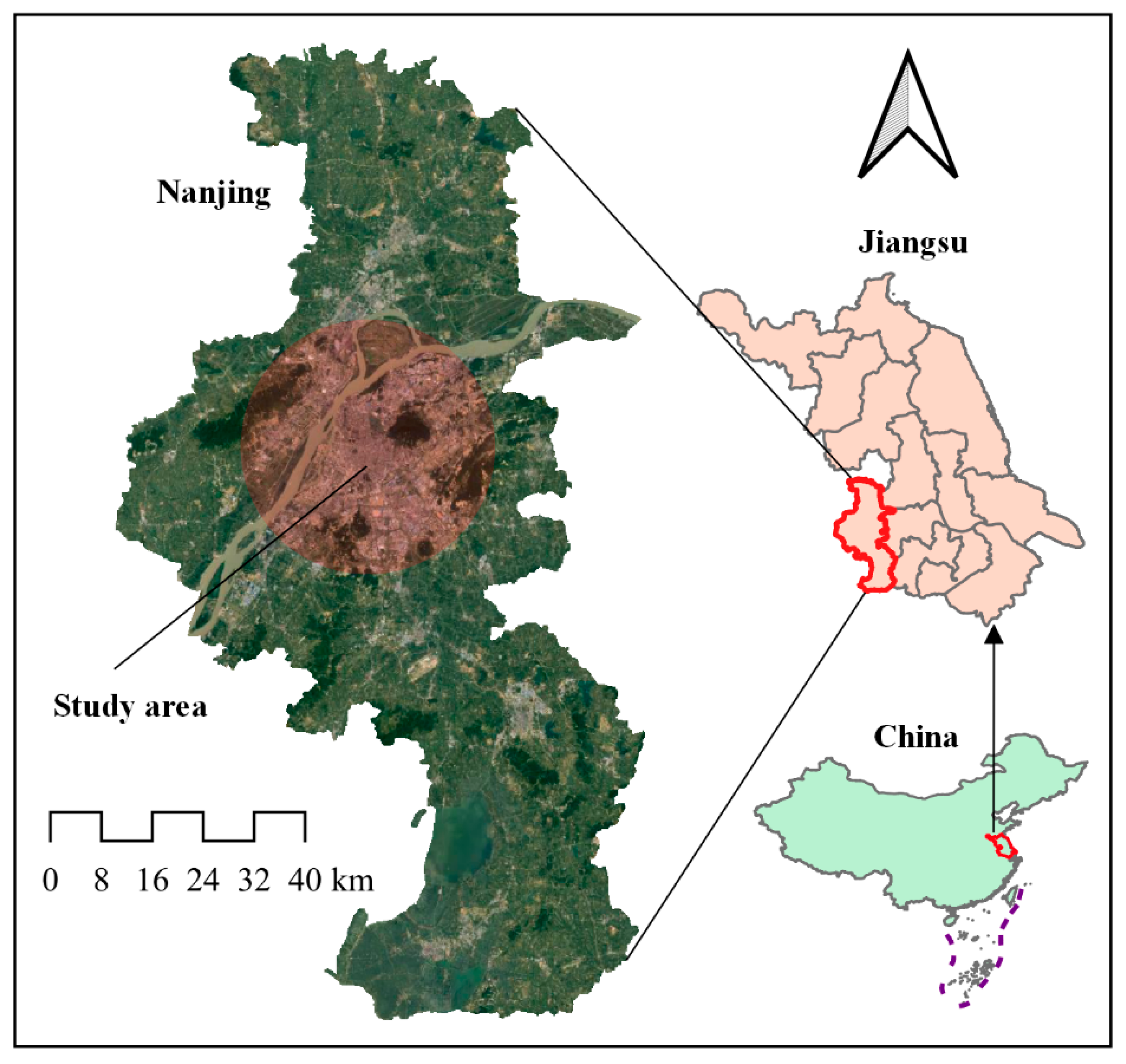
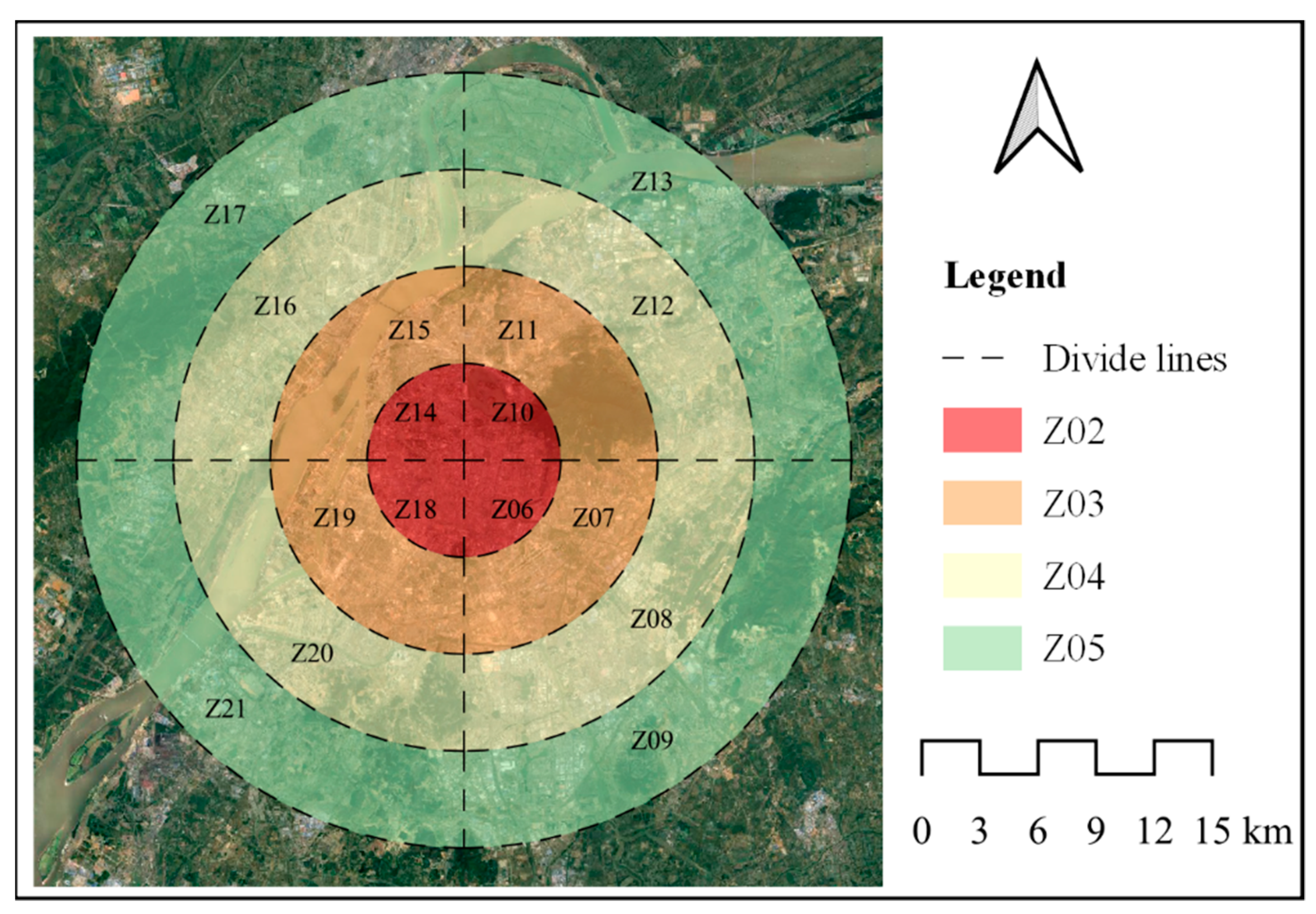
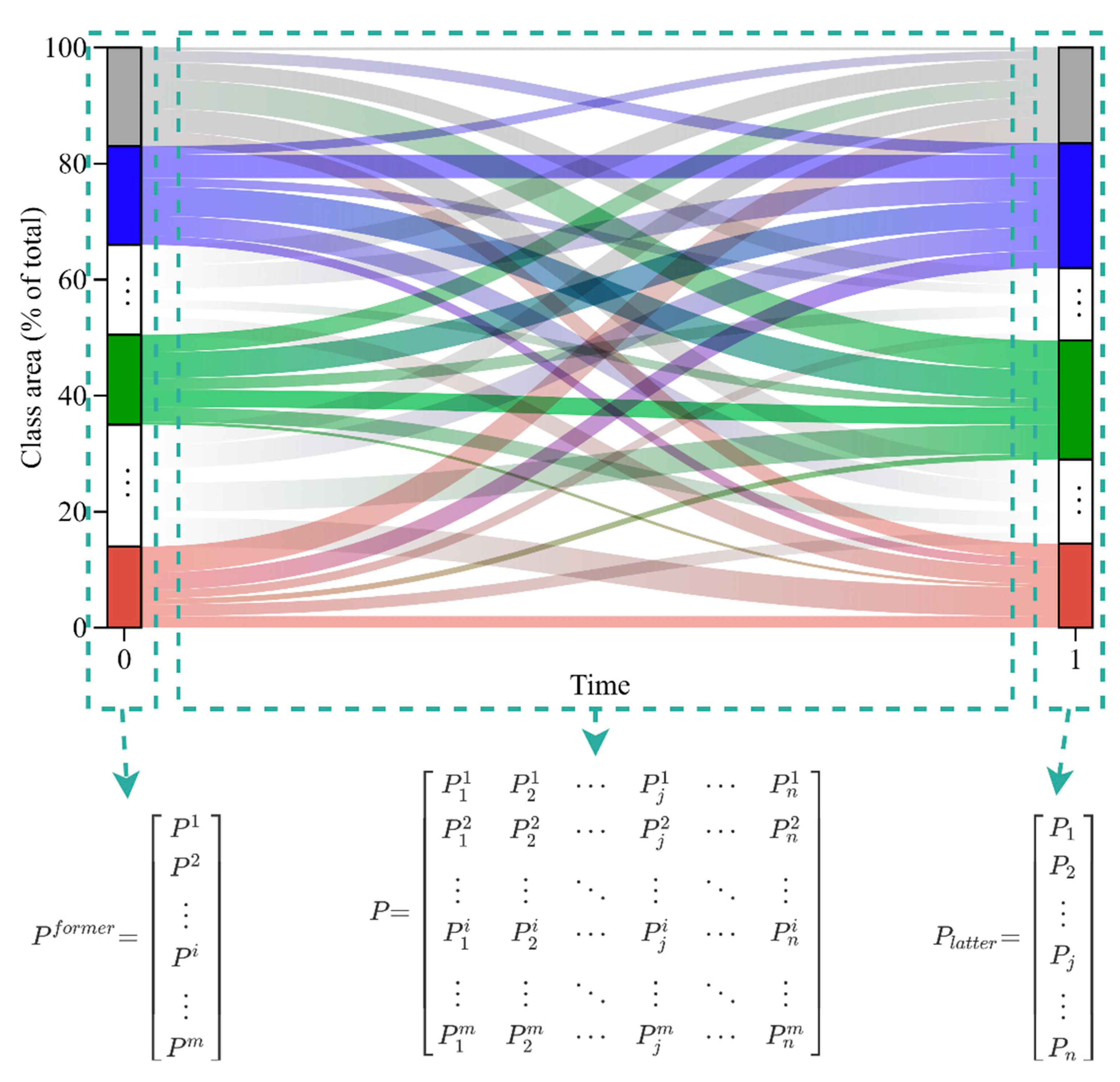
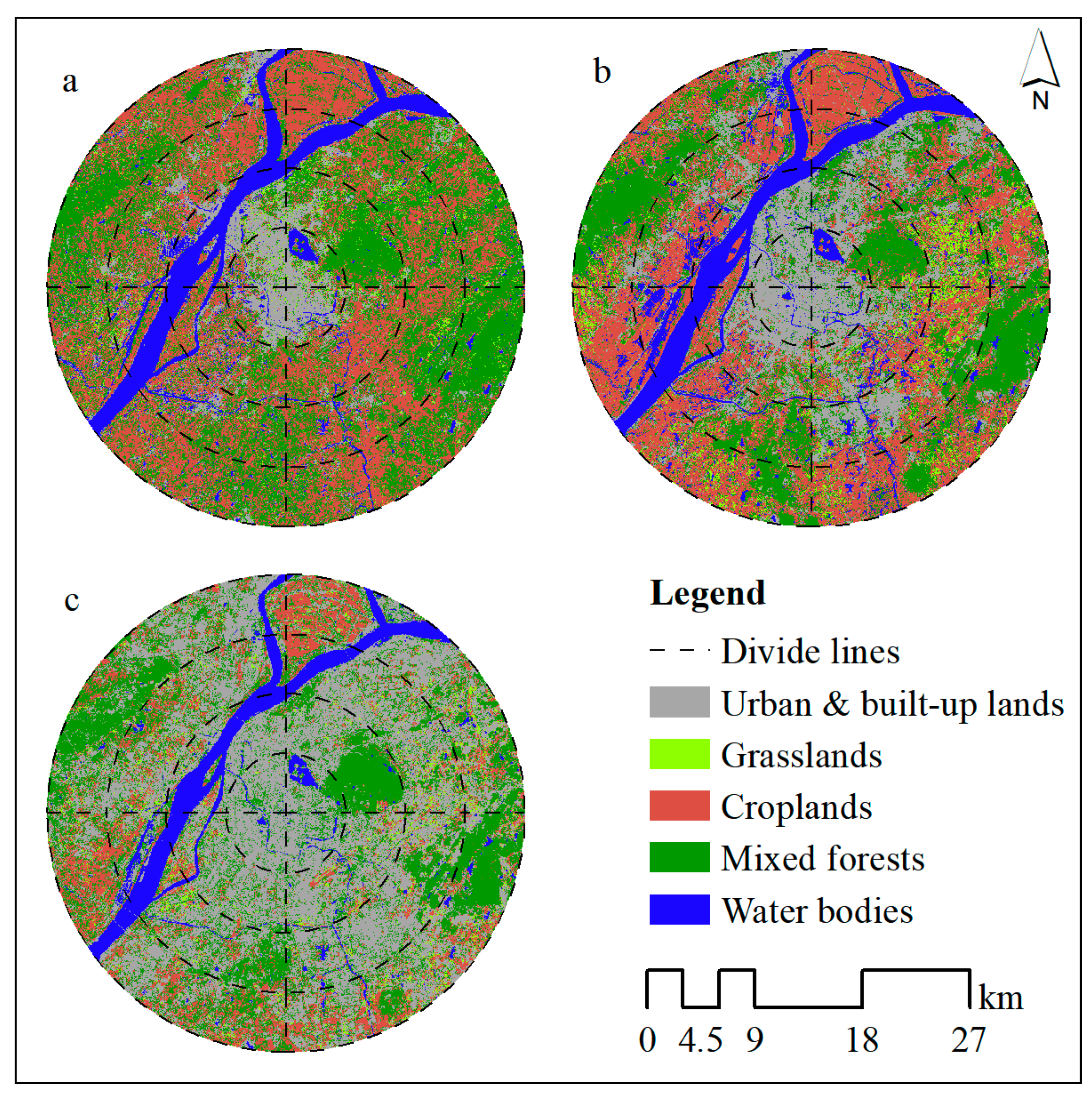
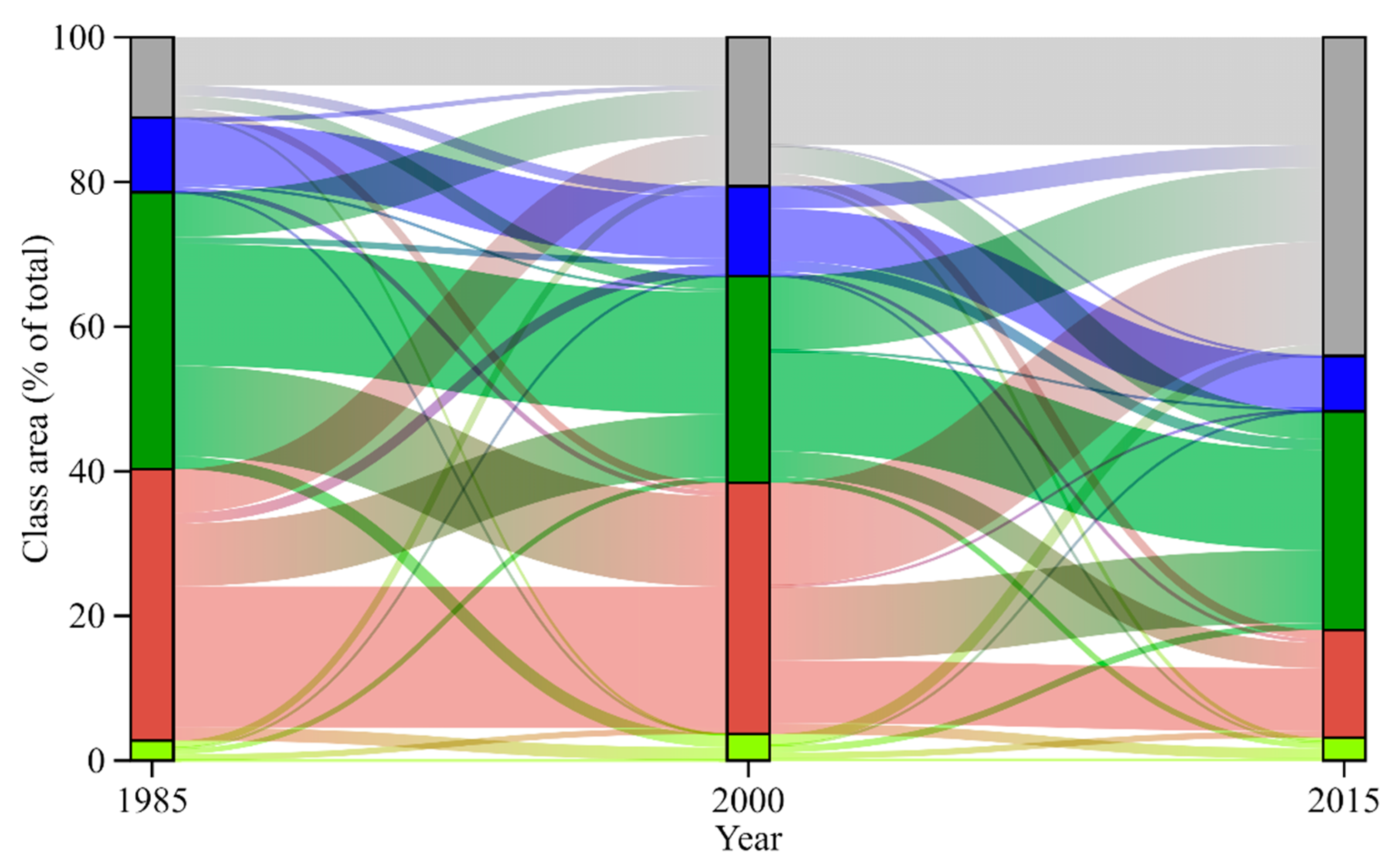
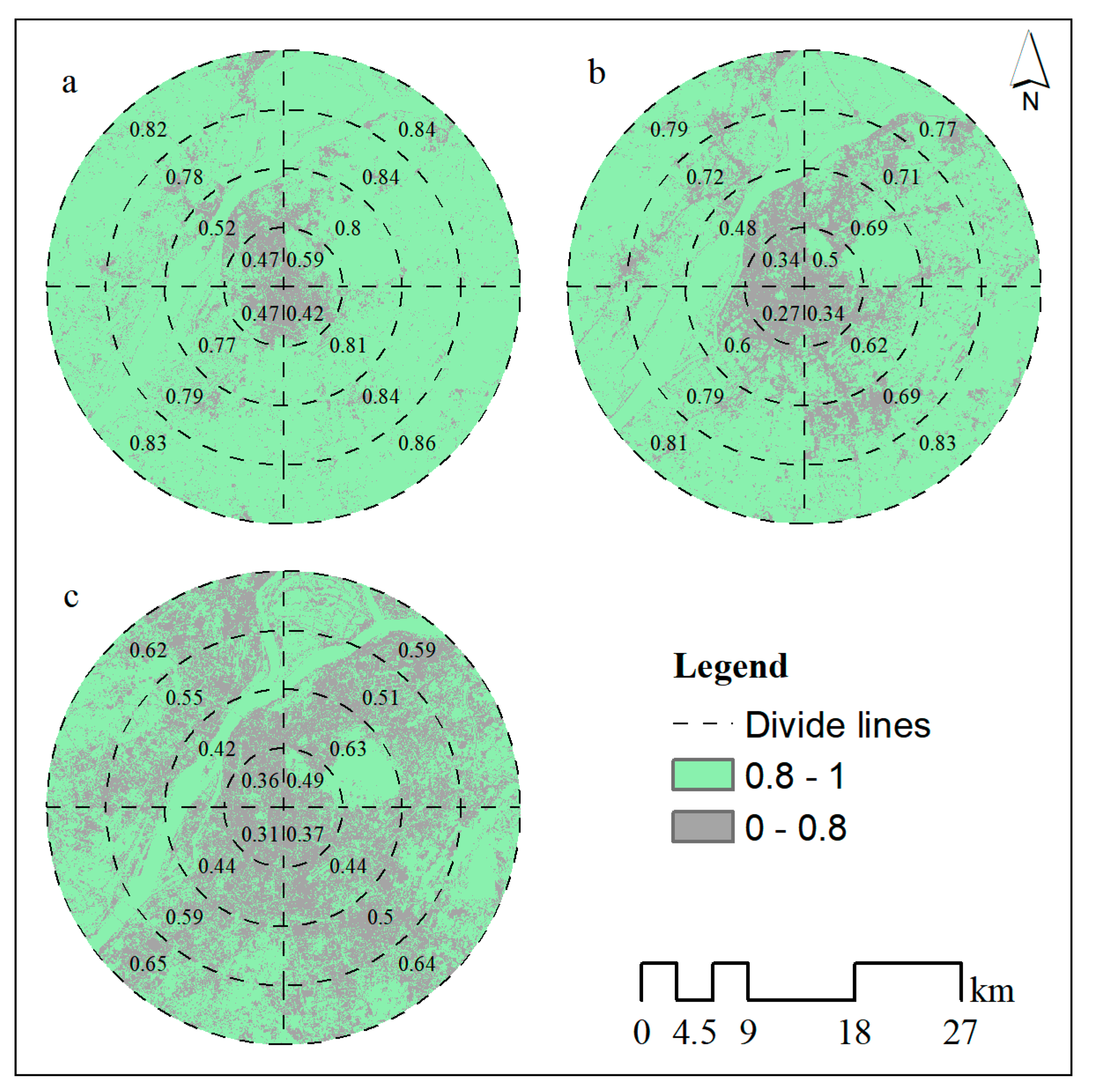
| 1985 | 1990 | 1995 | 2000 | 2005 | 2010 | 2015 | |
|---|---|---|---|---|---|---|---|
| Images | Landsat 4 TM/Landsat 5 TM | Landsat 4 TM/Landsat 5 TM | Landsat 5 TM | Landsat 5 TM/Landsat 7 ETM+ | Landsat 5 TM | Landsat 5 TM | Landsat 8 OLI |
| Bands | B1/B2/B3/B4/B5/B7 | B2/B3/B4/B5/B6/B7 | |||||
| Horizontal Resolution | 30 m | ||||||
| LULC Type | Short-Duration Runoff Coefficient * |
|---|---|
| Urban and built-up lands | 0.8 |
| Mixed forests | 0.1 |
| Croplands | 0.15 |
| Grasslands | 0.1 |
Publisher’s Note: MDPI stays neutral with regard to jurisdictional claims in published maps and institutional affiliations. |
© 2021 by the authors. Licensee MDPI, Basel, Switzerland. This article is an open access article distributed under the terms and conditions of the Creative Commons Attribution (CC BY) license (http://creativecommons.org/licenses/by/4.0/).
Share and Cite
Liu, X.; Fu, D.; Zevenbergen, C.; Busker, T.; Yu, M. Assessing Sponge Cities Performance at City Scale Using Remotely Sensed LULC Changes: Case Study Nanjing. Remote Sens. 2021, 13, 580. https://doi.org/10.3390/rs13040580
Liu X, Fu D, Zevenbergen C, Busker T, Yu M. Assessing Sponge Cities Performance at City Scale Using Remotely Sensed LULC Changes: Case Study Nanjing. Remote Sensing. 2021; 13(4):580. https://doi.org/10.3390/rs13040580
Chicago/Turabian StyleLiu, Xiaolong, Dafang Fu, Chris Zevenbergen, Tim Busker, and Meixiu Yu. 2021. "Assessing Sponge Cities Performance at City Scale Using Remotely Sensed LULC Changes: Case Study Nanjing" Remote Sensing 13, no. 4: 580. https://doi.org/10.3390/rs13040580
APA StyleLiu, X., Fu, D., Zevenbergen, C., Busker, T., & Yu, M. (2021). Assessing Sponge Cities Performance at City Scale Using Remotely Sensed LULC Changes: Case Study Nanjing. Remote Sensing, 13(4), 580. https://doi.org/10.3390/rs13040580











